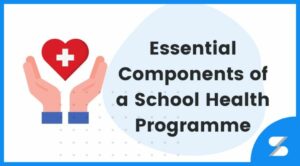Back to: Physical and Health Education JSS 2
Welcome to class!
In today’s class, we shall be talking about the components of school health programmes. Please enjoy the class!
Components of School Health Programmes

Imagine a school. Now, picture it buzzing with not just academic pursuits, but also vibrant energy focused on well-being. That’s the essence of a school health program! It’s like a superhero team, each member working together to empower students to lead healthy, fulfilling lives. Today, we’ll dissect this superhero team, exploring the core components that make school health programs tick.
1. Comprehensive School Health Education:
This is the brain of the team, providing students with the knowledge and skills to make informed choices about their health. Think of it as a roadmap to healthy living, covering topics like:
Physical health: Nutrition, exercise, disease prevention, body image.
Mental and emotional health: Stress management, coping skills, relationships, mental health awareness.
Social health: Communication, conflict resolution, teamwork, positive relationships.
2. Physical Education and Activity:

Get ready to move it! This component gets students’ hearts pumping and bodies grooving. It’s not just about gym class; it’s about incorporating movement and physical activity throughout the school day. Think:
Interactive PE lessons: From team sports to dance fitness, making physical activity engaging and enjoyable.
Active breaks: Short bursts of movement throughout the day to boost energy and focus.
Safe and accessible playgrounds: Encouraging spontaneous physical activity during breaks and recess.
3. Nutrition Services:
Fueling young minds and bodies is crucial! This component ensures students have access to healthy and nutritious food. Think:
Balanced school meals: Providing lunches and snacks that meet dietary needs and preferences.
Nutrition education: Teaching students about healthy eating habits and making informed food choices.
Community partnerships: Collaborating with local farms and organizations to promote healthy food access.
4. School Health Services:
This is the on-site medical team, ensuring students have access to basic healthcare services. Think:
Regular health screenings: Monitoring growth, vision, hearing, and overall well-being.
Immunizations: Keeping students protected from preventable diseases.
First-aid and emergency care: Addressing minor injuries and illnesses promptly.
5. School Counseling, Psychological and Social Services:
Mental and emotional well-being are just as important as physical health. This component provides students with the support they need to thrive. Think:
Individual and group counseling: Addressing issues like anxiety, depression, and peer pressure.
Social-emotional learning (SEL): Building skills like self-awareness, empathy, and healthy relationships.
Crisis intervention: Providing support in times of personal or family crisis.
6. Healthy and Safe School Environment:
The school itself should be a haven for health! This component focuses on creating a safe and supportive environment. Think:
Clean and well-maintained facilities: Ensuring hygiene and preventing accidents.
Positive school climate: Fostering respect, inclusivity, and bullying prevention.
Access to safe drinking water and sanitation facilities: Promoting basic hygiene practices.
7. Student, Family and Community Involvement:
School health thrives on collaboration! This component brings together students, families, and the community to support healthy choices. Think:
Parent education workshops: Empowering families to support healthy habits at home.
Student leadership programs: Engaging students in promoting health awareness and initiatives.
Community partnerships: Collaborating with local health organizations and businesses to expand resources.
8. Health Promotion for School Staff:
Healthy teachers mean healthy students! This component ensures that school staff are well-equipped to promote health and well-being. Think:
Staff wellness programs: Supporting the physical and mental health of teachers and other staff.
Professional development on health topics: Equipping staff with knowledge and skills to address student health needs.
Creating a culture of health and well-being within the school community: Encouraging healthy choices for everyone.
School health programs are not just about textbooks and gym classes; they’re about empowering students to live their healthiest lives. By understanding the different components and their interconnectedness, we can work together to create schools that are not just places of learning, but also sanctuaries for well-being. Remember, a healthy school community is a thriving school community, and that’s something worth fighting for!
We have come to the end of today’s class. I hope you enjoyed the class!
In the next class, we shall be discussing Goals and Objectives of School Health Programmes.
In case you require further assistance or have any questions, feel free to ask in the comment section below, and trust us to respond as soon as possible. Cheers!
Question Time:
- Explain the three core pillars of a comprehensive school health program.
- Describe the difference between physical education and physical activity in the context of a school health program.
- What are some challenges schools face in providing access to healthy and nutritious food?
- Discuss the role of school counselors and psychologists in a school health program.
- How can a healthy and safe school environment contribute to student learning and well-being?

wonderful notes, kindly share pdf of this notes please